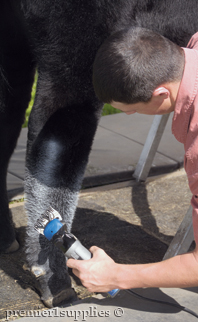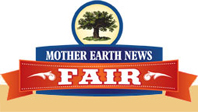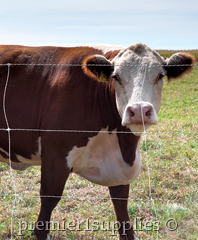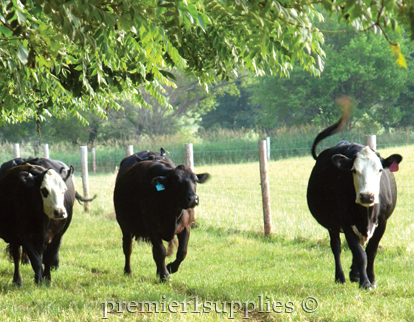SHOW READY?

When using a Phantom S Comb with a Premier 4000s Shearing Machine, make sure the cutter is set forward even with the tips of the comb.
Show season is just around the corner and folks are digging into their show-boxes to make sure their equipment is ready. Below is a quick refresher as to which shearing/clipping machines and their combs/cutters and blades to use.
Blocking
Peeling
Shaving
| • |
Premier 4000c with either Fine or Medium blades for shaving the head, brisket and/or tail. |
| • |
Saphir Clipper with #10 Heiniger blades for the udder. It’s very easy to use (cordless and lightweight) and uniquely powerful. Some use it for the head and tail. |
Professional sharpening services available.
MOTHER EARTH NEWS FAIR
 Visit us at Mother Earth News Fair
Visit us at Mother Earth News Fair
Premier's booth #1570 & 1571
Puyallup, WA
May 31-June 1, 2014
Premier's booth #151 & 153
Seven Springs, PA
September 12-14, 2014
Premier's booth #TBA
Topeka, KS
October 25-26, 2014
SIMPLE FENCE SOLUTIONS

Users like Cattle QuikFence™ because it's so fast and easy to install/remove—and because it's very effective for cows, calves, bulls, heifers and steers.
Electrified
Netting Options
Temporary
Semi-Permanent
Not sure which type of electrifiable netting you need? View our Netting Chart.
Energizer Options
Energizer Kits
Why purchase an energizer kit? Users tell us that kits simplify their purchasing decisions—because electrified fences require energizers, ground rods, accessories, etc. And for those with minimal experience, it’s complicated to choose and buy multiple components and build fences.
You can also view our
energizer comparison charts
|
 |
 |

It's calving season, which means it's also ear tag season. The tags in the cattle above are Z-Tags, an easy to apply one-piece tag.
Spring Pastures
It's been quite the treat seeing the cow/calf pairs in our neighbors' pastures. Our pastures are full of ewes and lambs, but we enjoy watching healthy, frisky calves on green grass as much as lambs.
The Premier folks who raise cattle have been readying their pastures for cows, calves and feeders to fatten. This means they're fixing tired fences and installing new ones as well as planting new pastures for hay and grazing later. Nice thing about a farm is there is always something to do.
We've included a few articles on pasture management for cattle and worming protocol (an article for the Eblex folks in the UK).
GREENER PASTURES
Five Steps to Better Pasture and Grazing Management
Washington State University, Clark County Extension
Grazing season has arrived, are your pastures ready? Good pastures provide forage for your animals, absorb rainfall, filter runoff, and reduce erosion, all of which protect streams. Even good pastures are susceptible to compaction during the rainy months and overgrazing year-round. Bare spots created by overgrazing encourage weed growth increased erosion, runoff, and dust, and may cause poor animal health. Although it may seem daunting, proper pasture management makes it feasible to have lush, green pastures, clean water, and healthy animals.
Pasture management should be thought of as grass farming. Think of the grasses as your crop, while you use animals to harvest that crop. Creating a good crop requires recognizing the differences between poor and good pasture management (Table 1, see under read more below). If pastures show characteristics representative of poor pasture management, there are five steps you can follow to improve and better manage your pastures: conducting an inventory, creating a sacrifice area, implementing rotational grazing, mowing and harrowing, and proper fertilizing.
1 - Pasture Inventory
Take a walk through each pasture and conduct an inventory of the grass and weed species, fences, gates, and water troughs. When conducting this inventory, determine what kinds and amounts of grass species currently growing and where they are located. Are there bare areas with no grass? Are some areas made up of only one grass species taller than the rest? Animals may overgraze some areas and under-use others due to
the species present. You also need to identify weeds in your pasture, particularly spe- cies that may be poisonous to your animals. Clark County Weed Management provides free on-site assistance to identify weeds and the best methods to control them (see Resources section).
Next, examine the condition of your fences. You may need to improve some fencing and add other fencing to improve animal distribu- tion and grazing. Providing additional water may be a necessary part of your pasture man- agement plan. Locate any streams, ditches, ponds, or wetlands in your pastures. Consider fencing animals away from these areas to minimize nutrient contamination and protect habitat for fish and wildlife.
A pasture inventory should also determine soil type and fertility. Use the Natural Resource Conservation Services online Web Soil Survey (see Resources) to determine your soil type. You can find out soil’s nutrient content of by submitting a soil sample to a local laboratory. Soil testing helps in selecting the correct type and amount of fertilizer and lime necessary to optimize growing conditions for a specific pasture. See the Resources section for additional information on how to take and submit a soil sample for analysis.
2 - Creating a Sacrifice Area: Rest for Tired Pastures
During the wet, winter months when soils are saturated and grass growth is minimal, it is important to rest your grass crop a rest. Allowing your animals to graze throughout the year significantly reduces grass growth later. Soil compaction results when animals graze on saturated soils, making it difficult for grass to grow in the spring. A sacrifice area provides a place to put animals while pastures rest. It is called a sacrifice area because a small portion of ground is “sacrificed” for the benefit of the remaining pasture. In the late summer when rain is limited and grasses go dormant, using this area will keep your pastures from being overgrazed. For more information on creating a sacrifice area as part of your pasture management, see the factsheet Reduce Mud and Keep Water Clean: Sacrifice Areas.
Grazing grass below three inches stresses the plant by reducing the leaf surface which grasses use to make their own food, thus forcing them to use up food reserves in their roots. Eventually, the grass depletes its stored reserves and dies, leaving bare spots in your pastures. Remember the Grazing Golden Rule: Keep grass at least three inches tall.
READ MORE »
The Small Acreage Program is sponsored in partnership by WSU Extension Clark County and the Clark County Clean Water Program.
FROM ENGLAND
Controlling Worms and Liver Fluke in Cattle for Better Returns
By EBLEX (An English Beef & Lamb Government Advisory Group)—United Kingdom
The threats
Endoparasites – organisms that attack an animal’s internal organs (as opposed to ectoparasites that affect the outer skin), cause the English cattle industry £millions in lost production and treatment costs.
Fortunately through better grazing management and/or the use of effective chemical treatments, these costs can be minimised.
Adult cattle generally acquire immunity to most of these parasites (except liver fluke), so treatment usually focuses on youngstock, particularly during their first grazing season when they are most at risk.
Wormer resistance
Resistance to wormers is now widely reported in the UK sheep industry, where they are used more intensively. This limits the treatment choices available to sheep farmers.
READ MORE »
|
|